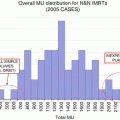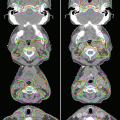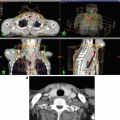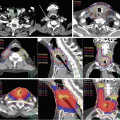Fig. 13.1
Scans for intensity-modulated radiation therapy to be given after an extrapleural pneumonectomy for mesothelioma, with representative sagittal, coronal, and axial slices and the dose-volume histogram (DVH)
13.3.3.2 IMRT with an Intact Lung
As noted above, we recommend that this technique be used only in the context of clinical protocols or at institutions with experience in using it. Our treatment method is as follows. Consistent with reported methods from other centers, our treatment volumes include an ITV “rind,” that is, a 5-mm expansion off the pleural bed (Fig. 13.2). These volumes are then expanded similarly to those for IMRT after EPP as described above, with sparing of the ipsilateral lung when feasible. The target is adjusted to account for respiratory motion and to include all at-risk pleural regions; the target is also expanded to include the scar and drain sites laterally if applicable. For patients with gross residual disease after surgery, limited studies have suggested using a concomitant boost, although again this technique must be considered experimental at this time and should not be attempted except in the context of a clinical trial or at a center with experience in its use.


Fig. 13.2
Scans for intensity-modulated radiation therapy to be given after a pleurectomy or decortication, with lung intact for mesothelioma, with representative sagittal, coronal, and axial slices and the dose-volume histogram (DVH). The normal tissue complication probability in this case was 24 %
13.3.4 Radiation Dose
Doses to microscopic disease when IMRT is to be used as adjuvant treatment are typically 45–50.4 Gy, given in 1.8-Gy fractions. A concomitant boost has been used to treat gross disease in limited studies, but this approach is not considered standard and its safety and efficacy have not been established.
13.3.5 Normal Tissue Constraints
We recommend standard thoracic normal tissue constraints to the esophagus (mean dose <34 Gy), heart (V 40 < 40 % or mean dose <20 Gy), and spinal cord (maximum dose <45 Gy). For left-sided disease, meeting heart constraints can be difficult while still covering the pericardium and anterior pericardial pleural bed and lymph nodes, and so treatment beyond these constraints is at the treating physician’s discretion. The current literature on this technique does not describe high rates of heart toxicity. Because the fields extend inferiorly to the kidneys, and for right-sided tumors to the liver, we recommend adhering to normal tissue constraints for these organs as well (liver V 30 < 40 %, mean dose <30 Gy; kidney V 20 < 33 %). As for lung constraints, for patients who have had an EPP, we recommend limiting the dose to the remaining lung to an MLD of <8.5 Gy and a V20 of <10 %. When treating patients with an intact lung, we use a normal tissue complication probability limit of <25 % to the total lung, and we also attempt to limit the contralateral lung to an MLD of <8.5 Gy and a V 20 of <10 %.
Acknowledgments
Supported in part by Cancer Center Support (Core) Grant CA016672 from the US National Cancer Institute to the University of Texas MD Anderson Cancer Center. We would like to sincerely thank Christine Wogan, MS, for her valuable assistance in editing this manuscript.
Conflict of Interest
The authors declare no conflicts of interest.
References
1.
2.
3.
4.
Ball D, Cruickshank DG (1990) The treatment of malignant mesothelioma of the pleura: review of a 5-year experience, with special reference to radiotherapy. Am J Clin Oncol 13:4–9CrossRefPubMed
Stay updated, free articles. Join our Telegram channel

Full access? Get Clinical Tree







